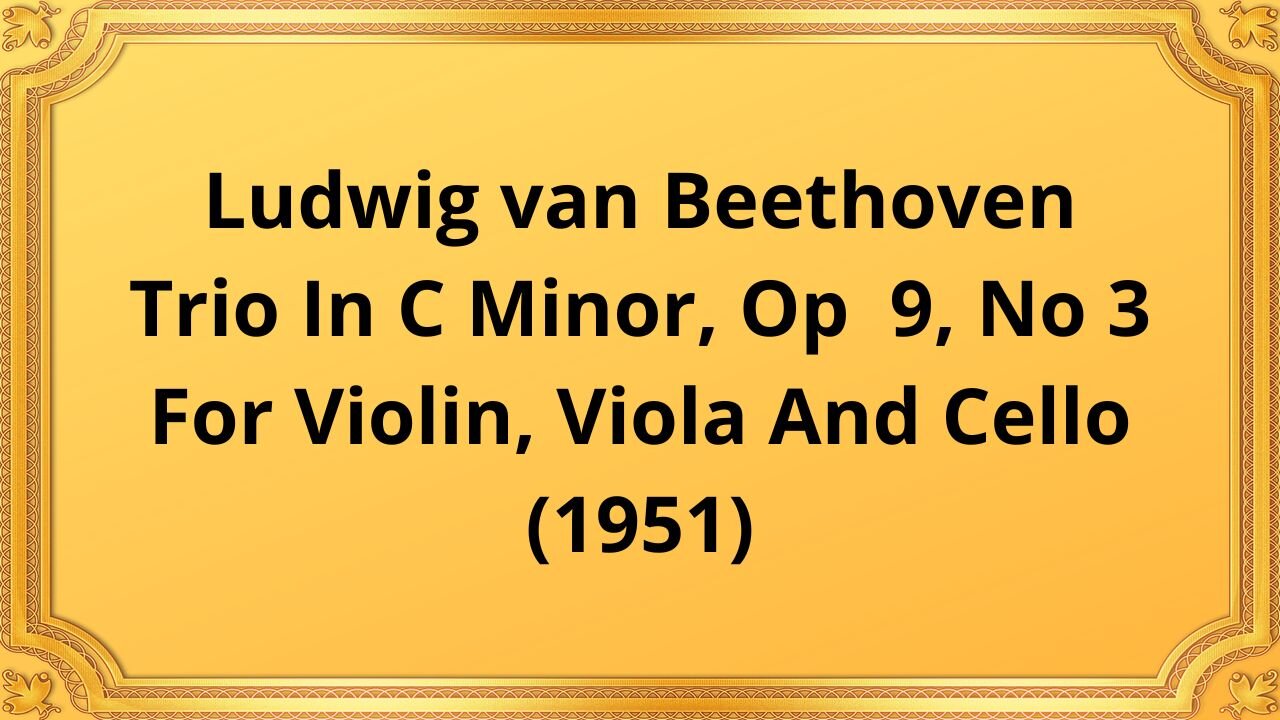Premium Only Content

Ludwig van Beethoven Trio In C Minor, Op 9, No 3 For Violin, Viola And Cello (1951)
#BeethovenTrio #ClassicalMusic #ChamberMusic #Violin #Viola #Cello #MusicHistory #ClassicalComposer #InstrumentalMusic #Op9No3 #MusicAppreciation #MusicalComposition #Beethoven #ClassicalArtistry #18thCenturyMusic
Publication date 1951
JULIUS BAKER, Flute * JOSEPH FUCHS, Violin + LILLIAN FUCHS, Viola + HARRY FUCHS, Cello
Ludwig van Beethoven's Trio in C Minor, Op. 9, No. 3 for Violin, Viola, and Cello is a masterful chamber music composition that showcases Beethoven's innovative approach to classical music. Composed in 1798, this trio is part of a set of three trios, Op. 9, which represent a significant leap in Beethoven's development as a composer, marking the transition from his early works to the more mature and groundbreaking compositions for which he is renowned.
The Trio in C Minor, Op. 9, No. 3 is structured in four movements, a common format for classical chamber music of this era. The first movement, marked Allegro con spirito, introduces the listener to the dramatic and passionate nature of the piece. Beethoven's use of chromaticism and harmonic tension creates a sense of urgency and emotional depth, setting the tone for the rest of the work.
The second movement, Adagio con espressione, provides a contrast to the intensity of the first movement. Here, Beethoven showcases his capacity for lyrical and expressive melodies, allowing each instrument to shine in its own right while maintaining a sense of unity within the trio.
The third movement, Scherzo: Allegro molto e vivace, injects a lively and playful energy into the composition. Beethoven's rhythmic drive and dynamic interplay between the instruments demonstrate his mastery of form and structure, captivating the listener with its spirited and dance-like character.
Finally, the trio concludes with the fourth movement, Finale: Presto, which brings the work to a thrilling and exhilarating close. Beethoven's use of virtuosic passages and contrapuntal writing highlights the technical prowess of the performers while delivering a powerful and satisfying conclusion to the musical journey.
Throughout the Trio in C Minor, Op. 9, No. 3, Beethoven's compositional innovation is evident. He pushes the boundaries of classical chamber music, experimenting with form, harmony, and expression to create a work that is both emotionally compelling and intellectually stimulating. The trio's exploration of the C minor key, known for its dramatic and melancholic qualities, adds an additional layer of depth and complexity to the composition, further showcasing Beethoven's ability to evoke a wide range of emotions through his music.
In conclusion, Ludwig van Beethoven's Trio in C Minor, Op. 9, No. 3 for Violin, Viola, and Cello stands as a testament to Beethoven's genius and his enduring impact on the development of classical music. Its combination of emotional depth, technical brilliance, and innovative spirit cements its place as a cornerstone of the chamber music repertoire, captivating audiences with its timeless beauty and profound musical expression.
-
 1:29:29
1:29:29
Glenn Greenwald
5 hours agoWith Biden Out, U.S. Finally Admits Harms of His Israel / Gaza Policy; Biden Pays Homage To George W. Bush; Insane Women’s Tennis Scandal: An “Abusive” Coach | SYSTEM UPDATE #388
35.8K31 -
 LIVE
LIVE
Danny Polishchuk
7 hours agoWho's To Blame For LA Fires, Jewish Tunnels Update + Forbidden Anthropology
304 watching -
 1:08:10
1:08:10
Donald Trump Jr.
7 hours agoOne Week Until Inauguration, Live with Rep Anna Paulina Luna & Sen Tommy Tuberville
106K104 -

The StoneZONE with Roger Stone
3 hours agoLAWFARE! Are Trump's Legal Assaults Winding Down? w/ Impeachment Lawyer David Schoen | The StoneZONE
23.7K -
 1:01:43
1:01:43
Patriots With Grit
22 hours agoShocking Changes Are Coming, If You Can Believe It | John Richardson
8.22K1 -
 8:00:59
8:00:59
Dr Disrespect
10 hours ago🔴LIVE - DR DISRESPECT - MARVEL RIVALS - TOP 500 IN THE WORLD
149K28 -
 54:46
54:46
LFA TV
1 day agoThe Soon-Coming Social Millennium | TRUMPET DAILY 1.13.25 7pm
24K2 -
 1:00:03
1:00:03
Sarah Westall
3 hours agoWeaponized Chaos – Worst in Modern History; Changing Geopolitical Landscape w/ Andy Schectman
20.7K2 -
 LIVE
LIVE
SpartakusLIVE
4 hours ago#1 Hacker/Scammer PLUNGES into CRYPTO || !crypto !spartacoin
213 watching -
 53:15
53:15
Kimberly Guilfoyle
7 hours agoCalifornia Residents Demand Answers, Live with Rep Vince Fong, Mike Davis, and Paul Peterson | Ep. 188
55.9K58